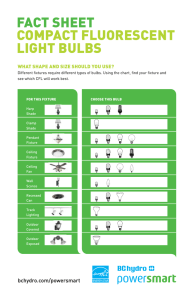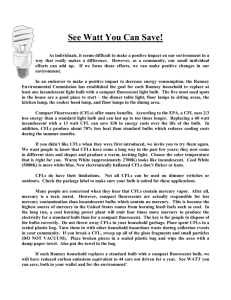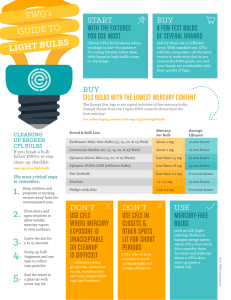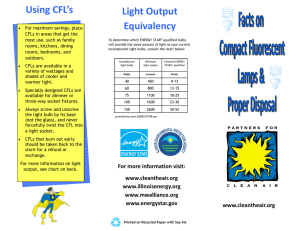Energy-efficient home lighting
advertisement
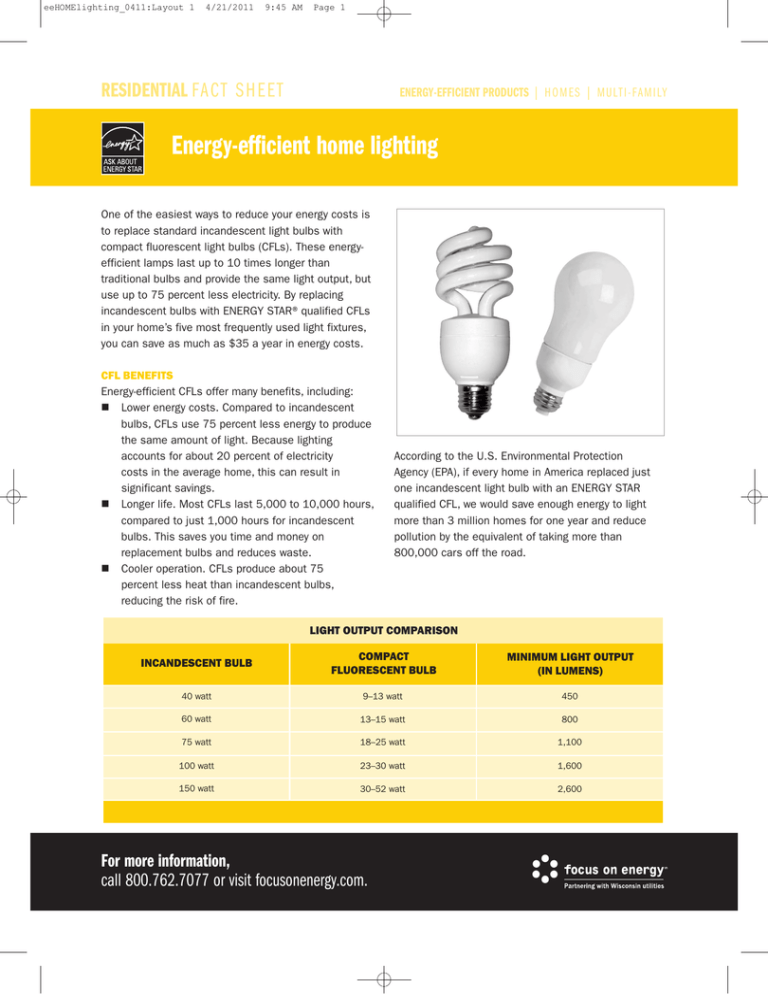
eeHOMElighting_0411:Layout 1 4/21/2011 9:45 AM Page 1 RESIDENTIAL FA C T S HE E T ENERGY-EFFICIENT PRODUCTS | HOM ES | MULTI-FAMILY Energy-efficient home lighting One of the easiest ways to reduce your energy costs is to replace standard incandescent light bulbs with compact fluorescent light bulbs (CFLs). These energyefficient lamps last up to 10 times longer than traditional bulbs and provide the same light output, but use up to 75 percent less electricity. By replacing incandescent bulbs with ENERGY STAR® qualified CFLs in your home’s five most frequently used light fixtures, you can save as much as $35 a year in energy costs. CFL BENEFITS Energy-efficient CFLs offer many benefits, including: Lower energy costs. Compared to incandescent bulbs, CFLs use 75 percent less energy to produce the same amount of light. Because lighting accounts for about 20 percent of electricity costs in the average home, this can result in significant savings. Longer life. Most CFLs last 5,000 to 10,000 hours, compared to just 1,000 hours for incandescent bulbs. This saves you time and money on replacement bulbs and reduces waste. Cooler operation. CFLs produce about 75 percent less heat than incandescent bulbs, reducing the risk of fire. According to the U.S. Environmental Protection Agency (EPA), if every home in America replaced just one incandescent light bulb with an ENERGY STAR qualified CFL, we would save enough energy to light more than 3 million homes for one year and reduce pollution by the equivalent of taking more than 800,000 cars off the road. LIGHT OUTPUT COMPARISON INCANDESCENT BULB COMPACT FLUORESCENT BULB MINIMUM LIGHT OUTPUT (IN LUMENS) 40 watt 9–13 watt 450 60 watt 13–15 watt 800 75 watt 18–25 watt 1,100 100 watt 23–30 watt 1,600 150 watt 30–52 watt 2,600 For more information, call 800.762.7077 or visit focusonenergy.com. eeHOMElighting_0411:Layout 1 4/21/2011 9:45 AM Page 2 LIGHT OUTPUT Light output is measured in lumens. Compared to incandescent bulbs, CFLs use far fewer watts of electricity to produce the same amount of lumens. Use the chart on the front to determine the right CFL for your needs. MANY SIZES AND STYLES CFLs come in a variety of shapes and sizes to fit almost every need. Today, you can find CFLs for dimmer switches, three-way lamps, recessed cans, and outdoor applications. Different fixtures require different types of bulbs. Use the chart above to find your fixture and determine which bulb will work best. COLOR TEMPERATURE Different bulbs emit different colors of light, from warm tones to cool. This is known as color temperature, and is measured in degrees Kelvin (K). In general, the lower the Kelvin temperature, the warmer (more yellow) the light; the higher the Kelvin temperature, the cooler (bluer) the light. ENERGY STAR qualified bulbs offer a range of colortemperature choices: Warm (2700°K to 3000°K): Warm color temperatures are preferred by people who like the color of light from incandescent bulbs. Lighting with warm color temperatures creates a welcoming atmosphere in living rooms, dining rooms, and bedrooms. Choose a bulb that states “warm white” or “soft white” on the package. Cool (3500°K to 4100°K): Cooler color temperatures are sometimes preferred for clean, clear light in kitchens and in bathrooms. Choose a bulb that states “cool white” or “bright white” on the package. Daylight (5000°K and up): This is the coolest color temperature available and is sometimes preferred for reading lamps. Choose a bulb that states “natural” or “daylight” on the package. eeHOMElighting_0411:Layout 1 4/21/2011 9:45 AM Page 3 LIGHTING TERMS AND DEFINITIONS CFL (compact fluorescent light bulb). A lowwattage, high-lumen lamp commonly replacing old-fashioned incandescent light bulbs today. Fluorescent lighting. Method of producing light by sending electrical current through a tube of ionized gas. Incandescent lighting. Method of producing light by heating a tungsten or halogen element. Lumens. A measure of brightness of a light source. An 18-watt CFL and a 75-watt incandescent bulb both provide about 1,100 lumens of brightness. Watts. A measure of electrical power. Kilowatt-hour (kWh). A kilowatt-hour is a measure of electricity used over time. For example, ten 100-watt light bulbs left on for one hour would use one kilowatt-hour (or 1,000 watt hours) of electricity. SHOPPING TIPS When shopping for CFLs, keep the following tips in mind: Look for the ENERGY STAR label for products that meet or exceed government energy-efficiency standards. Select a CFL that uses one-third the wattage of the incandescent bulb you’re replacing. For example, replace a 75-watt incandescent with an 18- to 25-watt CFL to ensure adequate illumination. (See “light output” chart on front page.) Check the size of your light fixture so you buy the correct bulb size. CFLs come in a range of shapes, sizes, and wattages. Choose the appropriate color temperature (warm or cool) to suit your taste and application. Select only dimmable bulbs for use with dimmer switches. Not all CFLs are suitable for use with dimmer switches. Choose only outdoor CFLs for use in outdoor applications. Moisture can shorten the life of standard CFLs. COMPACT FLUORESCENT FIXTURES When purchasing new fixtures (floor or table lamps, wall, ceiling-mounted, or outdoor fixtures), look for ENERGY STAR qualified models. These fixtures are available in many styles and sizes and use energyefficient fluorescent bulbs (CFLs or tubes). Because they use CFLs, these fixtures use up to 75 percent less energy and operate at cooler temperatures for improved safety. TORCHIERES Compact fluorescent torchiere floor lamps, available since 1997, use a CFL that delivers more lumens per watt than their halogen counterparts and burn an average of 750 degrees Fahrenheit cooler. Their higher purchase price is quickly offset by lower operating costs; a compact fluorescent torchiere can save you up to $180 in energy costs over its lifetime. Because they operate so much cooler, they are significantly safer to use. CFLs AND THE ENVIRONMENT The growing popularity of CFLs has prompted some to question the bulbs’ mercury content and its effect on the environment. Like all fluorescent lamps, CFLs contain small amounts of mercury. Yet they are perfectly safe to use. They do not emit mercury when they are intact, in use, properly stored, handled, and/or installed. And because CFLs use less electricity, they are actually responsible for fewer mercury emissions than traditional incandescent bulbs. A power plant will emit more mercury producing the electricity to light an incandescent bulb than to run a CFL for the same length of time. CFLs contain an average of five milligrams (mg) of mercury per bulb. By comparison, some watch batteries contain 25 mg of mercury and many manual thermostats contain up to 3,000 mg. (See chart on the next page.) PROPER DISPOSAL OF CFLs Because CFLs contain a small amount of mercury (about equivalent in size to the tip of a ball-point pen), the U.S. Environmental Protection Agency (EPA) recommends that consumers take advantage of local recycling options, such as recycling centers and transfer stations, to dispose of CFLs. Many communities schedule household waste collection eeHOMElighting_0411:Layout 1 4/21/2011 9:45 AM Page 4 Energy-efficient home lighting events when fluorescent lamps are collected along with paints, pesticides, used motor oil, and other materials. MERCURY CONTENT OF CFLs VS. OTHER COMMON HOUSEHOLD PRODUCTS. Product Amount of Mercury Number of Equivalent CFLs Compact fluorescent bulb An average of 5 milligrams 1 Watch battery 25 milligrams 5 Dental amalgams 500 milligrams 100 Home thermometer 500 mg – 2 grams 100–400 Float switches in sump pumps 2 grams 400 Tilt thermostat 3 grams 600 Recycle your used CFLs for free Focus on Energy has partnered with nearly 400 retailers across the state to offer free CFL recycling to consumers. Simply bring your expired, unbroken CFLs to a participating retailer, who will ship them to an environmental management center to be recycled in accordance with environmental regulations. Visit focusonenergy.com/cflrecycling for a list of participating retailers. If there are none in your area, contact your local municipal solid waste agency. CLEANUP OF BROKEN CFLs If a CFL breaks, take care in cleaning up. Even though the amount of mercury is very small (less than the mercury in your average watch battery and just enough to cover the tip of a ballpoint pen), EPA recommends the following steps: Open nearby windows to disperse any vapor that may escape. On hard surfaces, carefully sweep up the glass fragments using stiff paper or cardboard (do not use a vacuum or broom) and place them in a lidded jar or sealed plastic bag. Use sticky tape, such as duct tape, to pick up any remaining small pieces and powder. Wipe the area with damp paper towels. Finally, place the towel in the plastic bag and dispose of it at your local recycling center. sticky tape, such as duct tape, to pick up any remaining small pieces and powder. If vacuuming is needed after all visible materials are removed, vacuum the area where the bulb was broken. Finally, remove the vacuum bag (or empty or wipe the canister) and put the bag or vacuum debris in a sealed plastic bag and dispose of at your local recycling center. For more information, visit www.energystar.gov/cflsandmercury. TAKE ACTION TODAY. SEE RESULTS TOMORROW. Lower energy costs. A healthier home. Cleaner air and water. These are the results when Wisconsin residents tap into energy efficiency and renewable energy. To find out how you can reduce energy costs and improve the comfort, safety, and durability of your home, call Focus on Energy at 800.762.7077 or visit focusonenergy.com. STAY CURRENT AND CONNECTED! Join our online conversation at focusonenergy.com/ socialnetworks to connect with people who share your interest in saving energy and money at home and work. Also, visit focusonenergy.com/incentives for the latest incentives and requirements as Focus offers are subject to change. MORE INFORMATION The Official ENERGY STAR Website Learn more about energy-efficient products that meet ENERGY STAR standards. The lighting product information pages cover CFLs, fixtures, and ceiling fans. energystar.gov U.S. Environmental Protection Agency Learn more about lamp recycling and find a recycling center in your area. epa.gov/bulbrecycling On carpets or rugs, carefully pick up the fragments and place them in a lidded jar or sealed plastic bag. Use Focus on Energy works with eligible Wisconsin residents and businesses to install cost-effective energy efficiency and renewable energy projects. Focus information, resources, and financial incentives help to implement projects that otherwise would not be completed, or to complete projects sooner than scheduled. Its efforts help Wisconsin residents and businesses manage rising energy costs, promote in-state economic development, protect our environment, and control the state’s growing demand for electricity and natural gas. For more information, call 800.762.7077 or visit focusonenergy.com. All information (e.g., energy savings, costs, testimonials) throughout this document is historical and based on data available at the time it was created. ©2010 Focus on Energy RES-2441-0111

